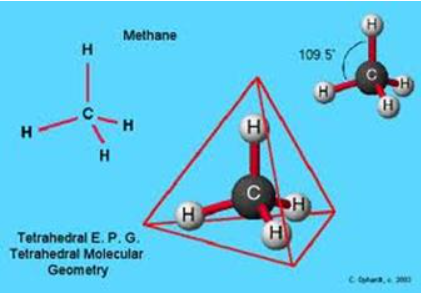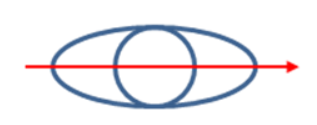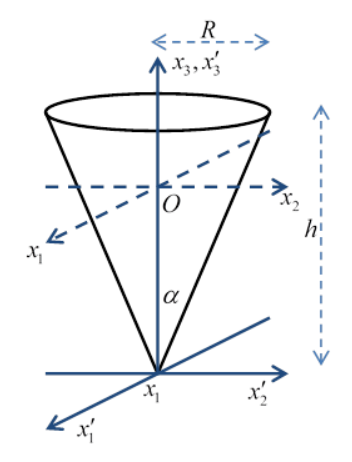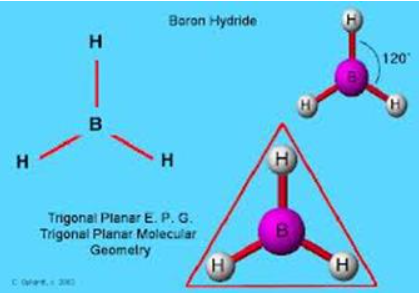25.1: Examples of Moments of Inertia
- Page ID
- 30532
Molecules
The moment of inertia of the hydrogen molecule was historically important. It’s trivial to find: the nuclei (protons) have 99.95% of the mass, so a classical picture of two point masses \(m\) a fixed distance \(a\) apart gives \(I=\frac{1}{2} m a^{2}\). In the nineteenth century, the mystery was that equipartition of energy, which gave an excellent account of the specific heats of almost all gases, didn’t work for hydrogen—at low temperatures, apparently these diatomic molecules didn’t spin around, even though they constantly collided with each other. The resolution was that the moment of inertia was so low that a lot of energy was needed to excite the first quantized angular momentum state, \(L=\hbar\) This was not the case for heavier diatomic gases, since the energy of the lowest angular momentum state \(E=L^{2} / 2 I=\hbar^{2} / 2 I\), is lower for molecules with bigger moments of inertia .
Here’s a simple planar molecule:
Obviously, one principal axis is through the centroid, perpendicular to the plane. We’ve also established that any axis of symmetry is a principal axis, so there are evidently three principal axes in the plane, one along each bond! The only interpretation is that there is a degeneracy: there are two equal-value principal axes in the plane, and any two perpendicular axes will be fine. The moment of inertial about either of these axes will be one-half that about the perpendicular-to-the-plane axis.
What about a symmetrical three dimensional molecule?

Here we have four obvious principal axes: only possible if we have spherical degeneracy, meaning all three principal axes have the same moment of inertia.
Various Shapes
A thin rod, linear mass density \(\lambda\), length \(ℓ\):
\begin{equation}
I=2 \int_{0}^{\ell / 2} \lambda x^{2} d x=2 \lambda \ell^{3} / 24=\frac{1}{12} m \ell^{2}
\end{equation}
A square of mass \(m\), side \(ℓ\), about an axis in its plane, through the center, perpendicular to a side:
\begin{equation}
I=\frac{1}{12} m \ell^{2}
\end{equation}
(It’s just a row of rods.) in fact, the moment is the same about any line in the plane through the center, from the symmetry, and the moment about a line perpendicular to the plane through the center is twice this—that formula will then give the moment of inertia of a cube, about any axis through its center.
A disc of mass \(M\), radius \(a\) and surface density \(\sigma\) has
\begin{equation}
I=\int_{0}^{a} r^{2} \cdot \sigma \cdot 2 \pi r d r=\frac{1}{2} \pi a^{4} \sigma=\frac{1}{2} M a^{2}
\end{equation}
This is also correct for a cylinder (think of it as a stack of discs) about its axis.
A disc about a line through its center in its plane must be \(\frac{1}{4} M a^{2}\) from the perpendicular axis theorem. A solid cylinder about a line through its center perpendicular to its main axis can be regarded as a stack of discs, of radius \(a\), height \(h\), taking the mass of a disc as \(\rho d z\) and using the parallel axes theorem,
\begin{equation}
I=2 \int_{0}^{h / 2} \rho d z\left(\frac{1}{4} a^{2}+z^{2}\right)=\frac{1}{4} M a^{2}+\frac{1}{12} M h^{2}
\end{equation}
For a sphere, a stack of discs of varying radii,
\begin{equation}
I=\int_{-a}^{a} d z \frac{1}{2} \rho \pi\left(a^{2}-z^{2}\right)^{2}=\frac{8}{15} \rho \pi a^{5}=\frac{2}{5} M a^{2}
\end{equation}
An ellipsoid of revolution and a sphere of the same mass and radius clearly have the same motion of inertial about their common axis (shown).

Moments of Inertia of a Cone

Following Landau, we take height \(h\) and base radius \(R\) and semivertical angle \(\alpha\) so that \(R=h \tan \alpha\).
As a preliminary, the volume of the cone is
\(V=\int_{0}^{h} \pi r^{2} d z=\int_{0}^{h} \pi\left(\frac{R z}{h}\right)^{2} d z=\frac{1}{3} \pi R^{2} h\)
The center of mass is distance \(a\) from the vertex, where
\begin{equation}
a V=a \cdot \frac{1}{3} \pi R^{2} h=\int_{0}^{h} z d V=\int_{0}^{h} \pi z\left(\frac{R z}{h}\right)^{2} d z=\frac{1}{4} \pi R^{2} h^{2}, \quad a=\frac{3}{4} h
\end{equation}
The moment of inertia about the central axis of the cone is (taking density \(\rho\)) that of a stack of discs each having mass
\begin{equation}
m(d z)=\pi r^{2} \rho d z=\pi\left(\frac{R z}{h}\right)^{2} \rho d z
\end{equation}
and moment of inertia \(I(d z)=\frac{1}{2} m(d z) r^{2}\)
\begin{equation}
\int_{0}^{h} \frac{1}{2} \pi \rho\left(\frac{R z}{h}\right)^{4} d z=\frac{1}{10} \pi \rho R^{4} h=\frac{3}{10} M R^{2}
\end{equation}
The moment of inertia about the axis \(x_{1}^{\prime}\) through the vertex, perpendicular to the central axis, can be calculated using the stack-of-discs parallel axis approach, the discs having mass \(\pi \rho\left(\frac{R z}{h}\right)^{2} d z\), it is
\begin{equation}
\int_{0}^{h} \pi \rho\left(\frac{R z}{h}\right)^{2}\left[\frac{1}{4}\left(\frac{R z}{h}\right)^{2}+z^{2}\right] d z=\frac{1}{20} \pi \rho R^{4} h+\frac{1}{5} \pi \rho R^{2} h^{3}=\frac{3}{20} M R^{2}+\frac{3}{5} M h^{2}
\end{equation}



